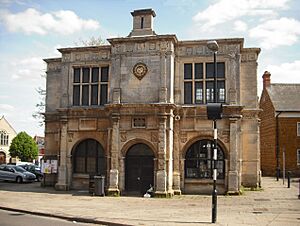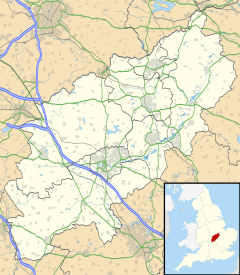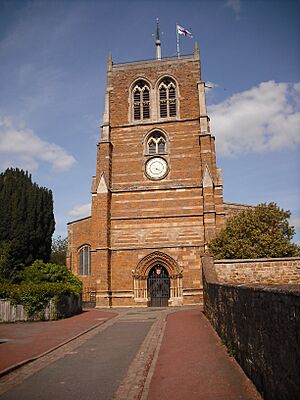Rothwell, Northamptonshire facts for kids
Quick facts for kids Rothwell |
|
|---|---|
 Rothwell Market House |
|
| Population | 7,694 (2011) |
| OS grid reference | SP815815 |
| Civil parish |
|
| District |
|
| Shire county | |
| Region | |
| Country | England |
| Sovereign state | United Kingdom |
| Post town | KETTERING |
| Postcode district | NN14 |
| Dialling code | 01536 |
| Police | Northamptonshire |
| Fire | Northamptonshire |
| Ambulance | East Midlands |
| EU Parliament | East Midlands |
| UK Parliament |
|
Rothwell is a lively market town located in North Northamptonshire, England. It's a great place to visit, sitting close to three bigger towns. You'll find it about 4 miles (6.4 km) northwest of Kettering, 7 miles (11 km) southeast of Market Harborough, and 8 miles (12.8 km) southwest of Corby. If you're traveling by train, the closest station is at Kettering, which is on the Midland Main Line.
Contents
Discovering Rothwell's History
Rothwell is built on a ridge that looks over the peaceful Ise Valley. This area has been home to people for thousands of years. About 4,000 years ago, people from the Bronze Age buried their dead here. They even left food offerings in special pots.
What Does "Rothwell" Mean?
Around 2,000 years ago, Romano-British people built a settlement where Rothwell is now. Later, invaders from the Danish area arrived. They founded a settlement called "Rodewell." This name likely meant "place of the red well." It probably got this name because of the many freshwater springs in the area. These springs were colored red by iron and other minerals.
There's another idea about the name. Some believe the name comes from Old English (Anglo-Saxon). It might mean a stream or spring near clearings in a forest.
Rothwell in the Middle Ages
By the early Middle Ages, Rothwell was already an important town. Locals often call it "Rowell." It was even more important than Kettering back then. This changed when the railway arrived in Kettering much later.
In 1204, King John gave Rothwell a special document called a charter. This charter allowed the town to hold a weekly market and a yearly fair. These traditions continue today! The market is held every Monday. The fair, known as "Rowell Fair," happens on Market Hill the week after Trinity Sunday. The famous Rothwell Market House was finished in 1578.
Rothwell has a rich past. It has a very large parish church, which is the longest in the county. This church even has a special room for bones, called a bone-crypt. The Market House was built by Thomas Tresham in 1578. Rothwell was once one of the three biggest towns in Northamptonshire. The other two were Northampton and Stamford (which is now in Lincolnshire). Rothwell is also on a pilgrimage route. This route goes from the old Benedictine Abbey at Peterborough to Santiago de Compostella. People still use this route today.
The Famous Rowell Fair
In 1204, King John gave Rothwell a royal charter. This important document gave the town the right to hold a market every Monday. It also allowed a yearly fair.
The charter said:
John, by the grace of God King, be it known that we have granted, and by this our present charter do confirm to our beloved and faithful Richard - Earl of Clare and his heirs that they may have their market of Rowell on Monday, with all the liberties and free customs to that market belonging as it was formerly [held] on Sunday, so that nevertheless it be not the hurt of neighbouring markets. Besides which we grant and by this our charter we have confirmed to the same Earl Richard and his heirs, that they may have yearly, a fair at Rowell at the feast of the Holy Trinity for and during the five days, that is to say on the eve of the Holy Trinity and on that day and on three following days, so nevertheless that such fair will not be to the hurt of neighbouring fairs. Wherefore we will and firmly declare that the aforesaid Earl Richard and his heirs may and hold the aforesaid market and the aforesaid fair of us and our heirs in perpetuity well and in peace, freely and quietly, rightly, fully and with honour, with all the liberties and free customs as aforesaid. Witness the Lord H. Archbishop of Canterbury, J Norwich and W. London Bishops etc. Given at Westminster the 26th day of January, in the fifth year
The town celebrates the granting of this charter every year with the week-long Rowell Fair. The fair officially begins on the first Monday after Trinity Sunday. In 2016, this was on May 23rd.
How the Fair Begins
The fair starts at 6 AM at the west door of Holy Trinity church. The bailiff of the Lord of the Manor rides through the town. He is joined by guards carrying halberds and the Rowell Fair Society Band. At each public house, he stops to read the old charter aloud. After each reading, the crowd cheers, "God save the Queen and the Lord of the Manor!" The band then plays the National Anthem. The owner of the pub then serves the bailiff and his guards drinks. This includes the traditional Rowell Fair rum and milk. After this, the local townspeople try to take the halberds from the guards! Then, the group moves to the next pub.
Many pubs in town stay open after this early morning event. This means there's lots of fun and celebration throughout the morning.
Places of Worship
Holy Trinity Church
Holy Trinity Church is a very important building. It is listed as a Grade I listed building.
The church has parts that are very old. The south chancel wall, with its special stone carvings, and three round windows are from the 11th century. The west tower was built around the 1170s. Most of the church, however, was built in the 13th century. The tower once had a tall spire. But in 1660, this spire fell down. It caused a lot of damage to the main part of the church, called the nave.
This church is about 173 feet (53 meters) long. This makes it the longest church in Northamptonshire. The church also hosts events. For example, in June 2013, the accordion player John Kirkpatrick gave a concert there.
The Bone Crypt
Holy Trinity Church has one of only two known bone crypts, or "charnel houses," in England. This crypt holds the bones of about 1,500 people! The only other surviving bone crypt is in St Leonard's Church in Hythe, Kent. Holy Trinity also has seven special wooden seats called misericords from the late 15th century. There's also one from the 1980s. It has a flower design to remember Doris Willcox, who passed away in 1974.
The United Reformed Church
The Rothwell United Reformed Church was built in 1735. It has a simple outside, but a beautiful and fancy inside. The history of Non-Conformism in Rothwell goes back to 1655. This means the town was where this religious movement started in the English Midlands.
Ironstone Quarrying in Rothwell
Rothwell is in an area that has a lot of iron ore. From 1920 to 1962, ironstone was dug up from large, shallow pits southeast of the town. These pits were connected by a steam-powered narrow gauge railway called the Kettering Ironstone Railway. This railway took the ironstone to ironworks north of Kettering.
These quarries first started north of the A6 road. But after 1925, most of the digging happened in an area roughly bordered by the A6 to the north, Loddington Road to the west, and Thorpe Malsor Reservoir to the south. There was also a quarry near Rothwell Grange, north of the A6. This one operated between 1923 and 1946 and was connected to the same railway. The Kettering Ironworks closed in 1959. After that, the ore was sent to Corby or other places to be melted down.
At first, workers dug the quarries by hand, using explosives to help. In 1933, a steam machine was brought in to help with digging. Then, in 1941, a diesel machine was used. You can still see signs of this quarrying today, like a sunken field near the cemetery.
There were also quarries north of Rothwell. These operated from 1900 to 1926 and again from 1959 to 1967. In the first period, the quarries were on both sides of the Desborough Road. The ore was taken by a 3-foot wide railway to train tracks near what was then Desborough and Rothwell Station. Steam locomotives were used at the quarry end. To cross the valley between Rothwell and Desborough, there was a cable system. This system pulled the wagons down into the valley and then up to the main railway line. Steam digging machines were used from 1911 onwards.
In the second period of operation, iron ore was only taken from the quarry on the west side of Desborough Road. It was first carried by lorry to just west of the road. From there, it traveled five and a quarter miles by an aerial ropeway to Oakley. Then, it went by another railway to Corby Works to be melted. Two electric (and one diesel) digging machines were used during this time. You can still see traces of these quarries. One is a rock face area called a gullett, which is now a nature reserve. Also, a small road had to be moved because of the quarrying.
Sports and Fun
Rothwell has a local football team called Rothwell Corinthians F.C.. They play their games at Seargeant's Lawn, on Desborough Road.
Until the end of the 2011–2012 season, Rothwell had another football club, Rothwell Town F.C.. This team had played in high-level leagues like the Southern Football League Premier Division. However, they currently don't have a home field. This is due to issues with who owns or rents the ground on Cecil Street, near Rothwell Junior School.
Town Twinning
Rothwell is connected with a small French town called Droué. Droué is near Blois in central France. This is a way for towns in different countries to become friends and learn about each other's cultures.
Schools in Rothwell
Rothwell has three schools for young people. These are Rothwell Victoria Infant School, Rothwell Junior School, and Montsaye Academy. Montsaye Academy is a secondary school that also has a sixth form for older students.
Rothwell Victoria Infant School and Rothwell Junior School work together closely.
See also
 In Spanish: Rothwell (Northamptonshire) para niños
In Spanish: Rothwell (Northamptonshire) para niños




